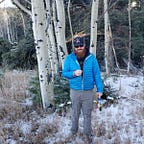When Science Leaps Before it Looks
When I first read Daniel Searwitz’s “Saving Science,” I immediately thought of the combined effort to create an image of the M87 Super Massive Blackhole’s Event Horizon. The project brought Albert Einstein’s theoretical model into reality. However, as I research this project as a case study, I quickly realized that I lack the technical background to explain this experiment thoroughly. Another example that came to mind was the Lokta-Volterra differential equation for predator-prey population dynamics. The other was an account from Aldo Leopold about his experiences when an observation was acted on as if it were fact, with little to no background research.
I chose these two various examples because they address the predator-prey population relationship. In Leopold’s lifetime, he witnessed the systematic extinction of wolves from the ecosystem of most states. States made this decision because of the observation that there were more deer in regions with fewer wolves. The theory was not entirely accurate. Lokta-Volterra demonstrates that the relationship between these two spices is more complex than a negative linear relationship. The Lokta-Volterra model gives a more detailed description of the relationship between wolves and deer. As predators decreased, prey increases, but when prey increases, predators increase, and as the predators increase, the prey decreases.
The question I wish to propose is: Should people act on information that science has yet to fully explore?
